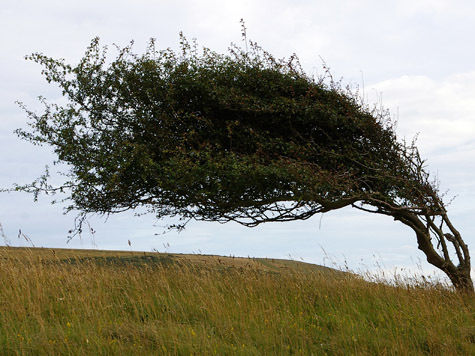Strong winds hit capital city

By Nazrin Gadimova
The north-westerly wind which broke out in Baku and Absheron peninsula on June 29 got stronger on June 30. The maximum speed of the wind reached 28-30 meters per second, while in some west areas it reached 16-28 meters per second.
Moreover, precipitation and lightning in many regions of Azerbaijan were observed with a depth of 9-18mm in the Greater Caucasus, in the Lesser Caucasus - 3-8mm, in the Central Aran - 2-6mm.
As a result, some trees were broken and electrical short circuit hit some houses. Moreover, the wind scattered construction waste on the roads, yards and streets.
Such strong winds are nothing new for residents of the capital - Baku for centuries is known as the Windy City, and even its name is decoded as 'the windswept city'. So, Baku residents have arranged their lifestyle by taking into account the fact that the strong wind is a frequent guest of the city.
The sudden changes in the weather create certain problems in the heart and blood vessels, Head of the Research Cardiology Institute Adil Bakhshaliyev believes.
He said that in the next 2-3 months, the institute will try to find out how the sudden changes of weather, radioactive rays and magnetic storms can affect the emergence and aggravation of diseases of the cardiovascular system.
"At the first stage of the research, some works will be done on theoretical questions and this will take about a couple of months or a little more," he said. "During this time, information will be collected from the first-aid stations, Astrophysical Observatory of ANAS, Ministry of Ecology and Natural Resources. The studies will examine five diseases related to the cardiovascular system - hypertension, coronary heart disease, arrhythmia, heart failure and myocardial infarction."
In addition to such seemingly obvious damages, wind and precipitation can spread infections, although this is a rather rare phenomenon.
Thus, a number of diseases pathogens are spread not only by diffusion, but also by the wind. For example, studies have shown that the foot-and-mouth disease - a very dangerous contagious disease that affects cattle, sheep and pigs - hit England and continental Europe in 1967-1968 only thanks to the wind. Spores of pests plant, particularly bunt affecting wheat can be transported by wind. So, England lost 75 percent of wheat crop in 1955, due to the smut, brought by the wind from North Africa and continental Europe.
The heavy rainfall combined with high temperature and humidity really contributes to the spread of certain types of diseases.
Epidemics of malaria, cholera, dysentery and plague broke out in some areas of the globe in the past in the hottest time of the year and after the big floods. However, all of these diseases were not due to the rainfall, but due to the high humidity and air temperature, which created favorable conditions for the development and rapid spread of disease carriers.
Researchers have found that bacteria, viruses and fungal spores, lingering on the dust particles can be carried by wind at a distance of several thousand miles. This phenomenon could adversely affect the health of people and the state of nature.
Scientists note that people living in areas where the highest part of the dust settles, often suffer from allergies, asthma and other respiratory diseases. The researchers also believe the "microbial" dust cause the death of coral reefs.
Florida, which became home to the considerable part of the dust, wind-blown from the Sahara desert can serve as example of this. The residents of this American state suffer from a number of respiratory diseases.
We advise residents and guests of the capital to stay on the streets in such weather as short as possible, and care much about it.
Here we are to serve you with news right now. It does not cost much, but worth your attention.
Choose to support open, independent, quality journalism and subscribe on a monthly basis.
By subscribing to our online newspaper, you can have full digital access to all news, analysis, and much more.
You can also follow AzerNEWS on Twitter @AzerNewsAz or Facebook @AzerNewsNewspaper
Thank you!
